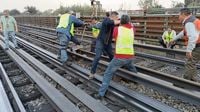On Wednesday, May 7, 2025, the Sistema de Transporte Colectivo (STC) Metro suspended service at the Deportivo Oceanía and Bosque de Aragón stations on Line B due to an unspecified operational failure. The interruption began at 16:25 hours, leading to the implementation of two circuits: one from Buenavista to Oceanía and another from Villa de Aragón to Ciudad Azteca, effectively cutting off passage between Oceanía and Villa de Aragón.
The director of the Metro, Adrián Rubalcava, reported that technical personnel were actively working to restore service as soon as possible. However, by 18:25 hours, no progress had been reported, leaving many passengers frustrated. A temporary measure was put in place, establishing a free transfer service with units from the Red de Transporte de Pasajeros (RTP) between Oceanía and Villa de Aragón to mitigate the impact on users.
The suspension of service ignited anger among commuters, with many reporting delays of up to 30 minutes even before the official closure of the stations. Passengers expressed their frustrations, highlighting the inconvenience caused by the unexpected disruption.
As the day progressed, the situation became clearer. A deformation in the tracks was identified as the cause of the suspension, prompting the need for a thorough technical review and profile adjustments to ensure the safety of users. Rubalcava emphasized the importance of these safety measures, stating, “The suspension was necessary to conduct a technical review of the tracks and adjustments that guarantee the safety of the users.”
For the second time in a week, the Metro service was halted due to technical issues, raising concerns among daily commuters who rely on this route connecting Buenavista with Ciudad Azteca. Videos and photos circulated on social media showing the deformed guide bar that led to the suspension, further fueling public discontent.
Metro personnel were present at the Oceanía station to inform users about the service interruption and to recommend alternative transportation options to the Villa de Aragón station. Passengers like Cristo Yanitzan and Jorge Mijangos voiced their frustrations, with Yanitzan noting, “They say it’s closed and that a bus will take us... they say.” Mijangos, who had experienced delays, remarked, “I’m already thinking about taking another form of transport because the bus they’re going to provide is probably going to take two or three hours.”
Many users expressed dissatisfaction with the lack of clear communication regarding the situation. Abigail Hernández stated, “They didn’t tell us exactly what happened. They just informed us that we had to get off. We don’t know what’s going on.” Others, like Mayra Calixto, questioned the effectiveness of the alternative transport arrangements, stating, “How are we going to get to work? It’s not fair.”
In response to the disruption, the Metro announced that service on the Bosque de Aragón and Deportivo Oceanía section would not resume until Thursday, May 8, 2025, at 5:00 hours. The decision to extend the suspension was made to allow for ongoing repairs and maintenance work on the tracks.
Rubalcava, who recently took over as the director general of the STC Metro following the resignation of Guillermo Calderón, faced his first major challenge with this service interruption. In a statement, he expressed gratitude for the support from the SSC-CDMX and the RTP in assisting users during this period. “From the Metro, we deeply appreciate the commitment and support from the SSC-CDMX and RTP to accompany and support our users on their way home or to their destinations. Their efforts make a difference,” he stated.
As the repairs continued overnight, the authorities urged users of Line B to remain vigilant and informed through official Metro channels. Commuters were advised to plan their journeys accordingly and to stay updated on the situation as it developed.
While the Metro service is expected to resume on schedule, the incident has sparked discussions about the reliability of public transportation in Mexico City and the need for ongoing maintenance to prevent such disruptions in the future. With thousands of passengers relying on the Metro every day, ensuring the safety and efficiency of the service remains a top priority for the STC Metro.
As the city awaits the restoration of service, many passengers are left pondering the reliability of their daily commutes and the measures in place to prevent future operational failures. The Metro's commitment to safety and effective communication will be crucial in regaining the trust of its users.






